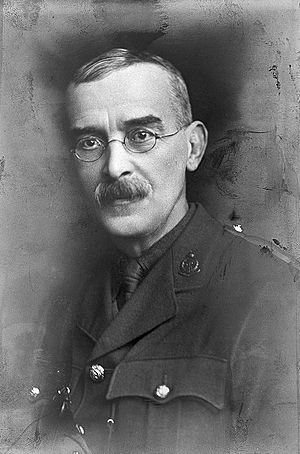John William Watson Stephens facts for kids
Quick facts for kids
John William Watson Stephens
|
|
|---|---|

photo courtesy of Wellcome Trust
|
|
| Born |
John William Watson Stephens
2 March 1865 Ferryside, Carmarthenshire, Wales
|
| Died | 17 May 1946 (aged 81) |
| Awards | Fellow of the Royal Society (1920) Manson Medal (1935) |
John William Watson Stephens (1865–1946) was a British scientist. He was an expert on parasites and diseases found in hot, tropical places. He helped us understand how these diseases spread and how to fight them.
Contents
Early Life and Education
John Stephens was born in Ferryside, Wales, on March 2, 1865. He went to school at Dulwich College. Later, he studied at Gonville and Caius College, Cambridge, starting in 1884. He earned his first degree there in 1887.
He then studied medicine at St Bartholomew's Hospital. He became a doctor in 1893. In 1894, he also got a special diploma in public health. This meant he was trained to help prevent diseases in communities.
A Career in Tropical Medicine
John Stephens dedicated his life to studying tropical diseases. From 1898 to 1902, he was part of the Royal Society's malaria commission. This group traveled to Africa and India to study malaria, a serious disease spread by mosquitoes.
He worked at the Liverpool School of Tropical Medicine. This was a very important place for studying diseases from warm climates. He taught there from 1903 to 1913. Later, he became a professor, taking over from another famous scientist, Sir Ronald Ross. He held this position until 1928.
During World War I, Stephens used his knowledge to help soldiers. He worked as a consultant on malaria for the Royal Army Medical Corps. He was also the president of the Royal Society of Tropical Medicine and Hygiene from 1927 to 1928.
Discoveries and Research
Stephens made important discoveries about different diseases.
Understanding Sleeping Sickness
With his colleague H. B. Fantham, Stephens did important work on sleeping sickness. This is a serious disease spread by the tsetse fly. They were the first to tell the difference between two types of the parasite that cause sleeping sickness. These types are called Trypanosoma brucei rhodesiense and Trypanosoma brucei gambiense.
Discovering a New Malaria Parasite
In 1914, Stephens was the first to describe a new type of malaria parasite. This parasite is called Plasmodium ovale. He found it in a blood sample from a patient in India. This discovery helped scientists better understand the different forms of malaria.
Later Life and Legacy
John Stephens married in 1901 and had two sons. After retiring, he moved back to his home area in Ferryside, Wales. He was elected a Fellow of the Royal Society in 1920. This is a very high honor for scientists in the UK. In 1935, he received the Manson Medal for his important work in tropical medicine.
He passed away on May 17, 1946. His work helped save many lives by improving our understanding of tropical diseases.
Selected Works
- French translation, published 1906

